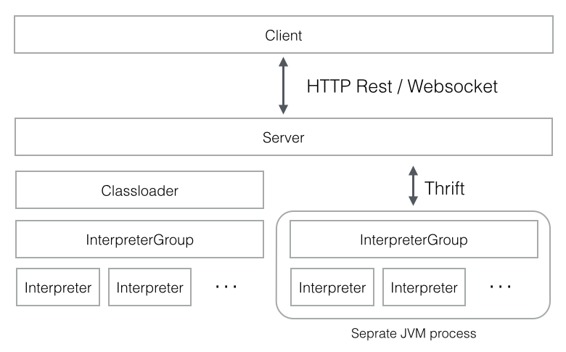# Writing a New Interpreter ( 写一个新的解释器 )
原文链接 : [http://zeppelin.apache.org/docs/0.7.2/development/writingzeppelininterpreter.html](http://zeppelin.apache.org/docs/0.7.2/development/writingzeppelininterpreter.html)
译文链接 : [http://www.apache.wiki/pages/viewpage.action?pageId=10030728](http://www.apache.wiki/pages/viewpage.action?pageId=10030728)
贡献者 : [小瑶](/display/~chenyao) [ApacheCN](/display/~apachecn) [Apache中文网](/display/~apachechina)
## 什么是 Apache Zeppelin Interpreter
**Apache Zeppelin Interpreter** 是一种语言后端。例如,在 **Zeppelin** 中使用 **scala** 代码,您需要一个 **scala** 解释器。每个解释器都属于一个解释器组。相同的解释器中的解释器可以互相引用。例如,**SparkSqlInterpreter** 可以引用 **SparkInterpreter** ,以便在它们在同一个组中时从其获取**SparkContext** 。

[**InterpreterSetting** ](https://github.com/apache/zeppelin/blob/master/zeppelin-zengine/src/main/java/org/apache/zeppelin/interpreter/InterpreterSetting.java)是给定的**[ InterpreterGroup](https://github.com/apache/zeppelin/blob/master/zeppelin-interpreter/src/main/java/org/apache/zeppelin/interpreter/InterpreterGroup.java)** 和一个启动/停止解释器的单元的配置。同一个 **InterpreterSetting** 中的所有解释器都在单独的 **JVM** 进程中启动。解释器通过 [**Thrift** ](https://github.com/apache/zeppelin/blob/master/zeppelin-interpreter/src/main/thrift/RemoteInterpreterService.thrift)与 **Zeppelin engine** 通信。
在创建新的解释器时,您可以在 “解释器设置” 菜单中看到“每个音符”模式的“单独的解释器(范围/隔离)”,每个音符将创建新的解释器实例。但是它们在同一个 **InterpreterSettings** 中仍然运行在同一个 **JVM** 上。
## 制作你自己的 Interpreter
创建一个新的 **interpreter** 是非常简单的。只需扩展 [**org.apache.zeppelin.interpreter** ](https://github.com/apache/zeppelin/blob/master/zeppelin-interpreter/src/main/java/org/apache/zeppelin/interpreter/Interpreter.java)抽象类并实现一些方法。您可以在构建系统中包含 **org.apache.zeppelin:zeppelin-interpreter:[VERSION] artifact**。您应该将您的 jar 放在您的解释器目录下,并具有特定的目录名称。 **Zeppelin** 服务器递归地读取解释器目录,并初始化包括您自己的解释器在内的 **interpreter** 。
有三个位置可以存储您的 **interpreter group**,**name** 和 其他信息。 **Zeppelin** 服务器尝试找到以下位置。接下来, **Zeppelin** 尝试在您的解释器 **jar** 中找到** interpreter-setting.json**。
```
{ZEPPELIN_INTERPRETER_DIR}/{YOUR_OWN_INTERPRETER_DIR}/interpreter-setting.json
```
以下是您自己的 **interpreter** 上的 **interpreter-setting.json** 的例子。
```
[
{
"group": "your-group",
"name": "your-name",
"className": "your.own.interpreter.class",
"properties": {
"properties1": {
"envName": null,
"propertyName": "property.1.name",
"defaultValue": "propertyDefaultValue",
"description": "Property description"
},
"properties2": {
"envName": PROPERTIES_2,
"propertyName": null,
"defaultValue": "property2DefaultValue",
"description": "Property 2 description"
}, ...
},
"editor": {
"language": "your-syntax-highlight-language",
"editOnDblClick": false
}
},
{
...
}
]
```
最后, **Zeppelin** 使用以下静态初始化:
```
static {
Interpreter.register("MyInterpreterName", MyClassName.class.getName());
}
```
**静态初始化已被弃用,直到 0.6.0 才会被支持。**
在解释器配置过程中,名称将会稍后出现在解释器名称选项框中。解释器的名字是您以后写的,以确定应使用此解释器解释的段落。
```
%MyInterpreterName
some interpreter specific code...
```
## Editor setting for Interpreter ( 解释器的编辑器设置 )
您可以将编辑器对象添加到** interpreter-setting.json** 文件中以指定段落编辑器设置。
### Language ( 语言 )
如果解释器使用特定的编程语言(如 Scala , Python , SQL ),则通常建议将语法突出显示添加到注释段落编辑器中。
要查看支持的语言列表,请参阅 **zeppelin-web / bower_components / ace-builds / src-noconflict** 或 [**github.com/ajaxorg/ace-builds** ](https://github.com/ajaxorg/ace-builds/tree/master/src-noconflict)下的 **model - *.js** 文件。
如果要添加一组新的语法高亮:
1. 将 **model-*.js** 文件添加到** zeppelin-web / bower.json** (当内置时, **zeppelin-web / src / index.html** 将自动更改)。
将语言字段添加到编辑对象。请注意,如果您不指定语言字段,则您的解释器将使用纯文本模式进行语法突出显示。假设您要将语言设置为 **java** ,然后添加:
```
"editor": {
"language": "java"
}
```
### Edit on double click ( 双击编辑 )
如果您的解释器使用标记语言(如 **markdown** 或 **HTML** ),请将 **editOnDblClick** 设置为 **true** ,以便文本编辑器在对话框上双击并在段落运行中关闭。否则将其设置为 **false** 。
```
"editor": {
"editOnDblClick": false
}
```
## Install your interpreter binary ( 安装你的解释器二进制文件 )
一旦您构建了您的解释器,您可以将其放在解释器目录下,并具有所有的依赖关系。
```
[ZEPPELIN_HOME]/interpreter/[INTERPRETER_NAME]/
```
## Configure your interpreter ( 配置您的解释器 )
要配置您的解释器,您需要遵循以下步骤:
1. 将解释器类名添加到 **conf / zeppelin-site.xml** 中的 **zeppelin.interpreters** 属性。属性值以逗号分隔 **[INTERPRETER_CLASS_NAME]** 。例如,
```
<property>
<name>zeppelin.interpreters</name>
<value>org.apache.zeppelin.spark.SparkInterpreter,org.apache.zeppelin.spark.PySparkInterpreter,org.apache.zeppelin.spark.SparkSqlInterpreter,org.apache.zeppelin.spark.DepInterpreter,org.apache.zeppelin.markdown.Markdown,org.apache.zeppelin.shell.ShellInterpreter,org.apache.zeppelin.hive.HiveInterpreter,com.me.MyNewInterpreter</value>
</property>
```
2. 将您的解释器添加到当没有 **zeppelin-site.xml** 时使用的默认配置。
3. 通过运行** ./bin/zeppelin-daemon.sh** 启动 **Zeppelin** 。
在解释器页面中,单击+创建按钮并配置您的解释器属性。现在你已经完成并准备好使用你的解释器。
注意
使用 **zeppelin** 发布的解释器有一个默认配置,当没有 **conf / zeppelin-site.xml** 时使用。
## Use your interpreter ( 使用你的解释器 )
### 0.5.0
在 **[NOTE]** 的指令中,**%[INTERPRETER_NAME]** 指令会调用您的解释器。请注意,**zeppelin.interpreters** 中的第一个解释器配置将是默认配置。
例如:
```
%myintp
val a = "My interpreter"
println(a)
```
### 0.6.0 and later
在一个注释的内部,**%INTERPRETER_GROUP].[INTERPRETER_NAME]** 指令将会调用您的解释器。
您可以省略 **[INTERPRETER_GROUP]** 或** [INTERPRETER_NAME]** 。如果您忽略** [INTERPRETER_NAME]** ,则会在** [INTERPRETER_GROUP]** 中选择第一个可用的解释器。同样,如果您跳过** [INTERPRETER_GROUP]** ,则会从默认解释器组中选择 **[INTERPRETER_NAME]** 。
例如,如果** mygrp group** 中有两个解释器 **myintp1** 和 **myintp2** ,可以像 **myintp1** 一样调用:
```
%mygrp.myintp1
codes for myintp1
```
你可以像 **myintp2** 一样调用
```
%mygrp.myintp2
codes for myintp2
```
如果省略您的解释器名称,它将在 **group ( myintp1 )** 中选择第一个可用的解释器。
```
%mygrp
codes for myintp1
```
当您的** interpreter group** 被选为 默认组 时,您只能省略您的** interpreter group** 。
```
%myintp2
codes for myintp2
```
## Examples ( 示例 )
查看一些与 **Zeppelin** 发布的 **interpreters** 。
* [spark](https://github.com/apache/zeppelin/tree/master/spark)
* [markdown](https://github.com/apache/zeppelin/tree/master/markdown)
* [shell](https://github.com/apache/zeppelin/tree/master/shell)
* [jdbc](https://github.com/apache/zeppelin/tree/master/jdbc)
## Contributing a new Interpreter to Zeppelin releases ( 为 Zeppelin 发行新的解释器 )
我们欢迎对新的解释器的贡献。请按照以下几个步骤进行:
* 首先,在 [这里](https://zeppelin.apache.org/contribution/contributions.html) 查看一般性贡献指南。
* 按照上述[ “解释器自己的解释器部分”](/pages/viewpage.action?pageId=10031094) 和 [“编辑器设置”](/pages/viewpage.action?pageId=10031094) 中的步骤进行。
* 添加您的解释器,如上面的 [配置您的解释器部分](/pages/viewpage.action?pageId=10031094) ;还将其添加到示例模板 **[zeppelin-site.xml.template](https://github.com/apache/zeppelin/blob/master/conf/zeppelin-site.xml.template)** 中。
* 添加测试!他们由 [Travis ](https://travis-ci.org/apache/zeppelin)经营所有变化,重要的是他们是独立的。
* 将您的解释器作为** pom.xml** 中的模块。
* 添加有关如何在 **docs / interpreter /** 下使用解释器的文档。以 **Markdown** 风格[为例](https://github.com/apache/zeppelin/blob/master/docs/interpreter/elasticsearch.md)。确保您列出配置设置,并提供在 **Markdown** 的代码框中使用解释器的工作示例。根据需要链接到图片(图片应转到** docs / assets / themes / zeppelin / img / docs-img /** )。并在导航菜单(**docs / _includes / themes / zeppelin / _navigation.html**)中添加您的文档的链接。
* 最重要的是,确保所有依赖关系的传递关闭的许可证在 [许可证文件 ](https://github.com/apache/zeppelin/blob/master/zeppelin-distribution/src/bin_license/LICENSE)中列出。
* 提交您的更改,并在 [**GitHub** 上的项目 **Mirror**](https://github.com/apache/zeppelin) 上打开一个[** Pull** 请求](https://github.com/apache/zeppelin/pulls);检查以确保 **Travis CI** 构建正在通过。
- 快速入门
- 什么是Apache Zeppelin?
- 安装
- 配置
- 探索Apache Zeppelin UI
- 教程
- 动态表单
- 发表你的段落
- 自定义Zeppelin主页
- 升级Zeppelin版本
- 从源码编译
- 使用Flink和Spark Clusters安装Zeppelin教程
- 解释器
- 概述
- 解释器安装
- 解释器依赖管理
- 解释器的模拟用户
- 解释员执行Hook(实验)
- Alluxio 解释器
- Beam 解释器
- BigQuery 解释器
- Cassandra CQL 解释器
- Elasticsearch 解释器
- Flink 解释器
- Geode/Gemfire OQL 解释器
- HBase Shell 解释器
- HDFS文件系统 解释器
- Hive 解释器
- Ignite 解释器
- JDBC通用 解释器
- Kylin 解释器
- Lens 解释器
- Livy 解释器
- Markdown 解释器
- Pig 解释器
- PostgreSQL, HAWQ 解释器
- Python 2&3解释器
- R 解释器
- Scalding 解释器
- Scio 解释器
- Shell 解释器
- Spark 解释器
- 系统显示
- 系统基本显示
- 后端Angular API
- 前端Angular API
- 更多
- 笔记本存储
- REST API
- 解释器 API
- 笔记本 API
- 笔记本资源 API
- 配置 API
- 凭据 API
- Helium API
- Security ( 安全 )
- Shiro 授权
- 笔记本 授权
- 数据源 授权
- Helium 授权
- Advanced ( 高级 )
- Zeppelin on Vagrant VM ( Zeppelin 在 Vagrant 虚拟机上 )
- Zeppelin on Spark Cluster Mode( Spark 集群模式下的 Zeppelin )
- Zeppelin on CDH ( Zeppelin 在 CDH 上 )
- Contibute ( 贡献 )
- Writing a New Interpreter ( 写一个新的解释器 )
- Writing a new Visualization (Experimental) ( 编写新的可视化(实验) )
- Writing a new Application (Experimental) ( 写一个新的应用程序( 实验 ) )
- Contributing to Apache Zeppelin ( Code ) ( 向 Apache Zeppelin 贡献( 代码 ) )
- Contributing to Apache Zeppelin ( Website ) ( 向 Apache Zeppelin 贡献(website) )
